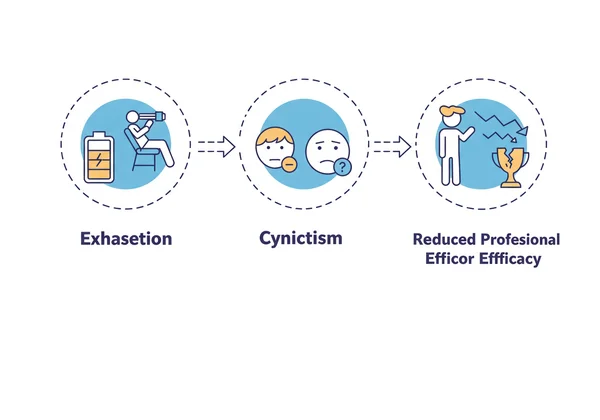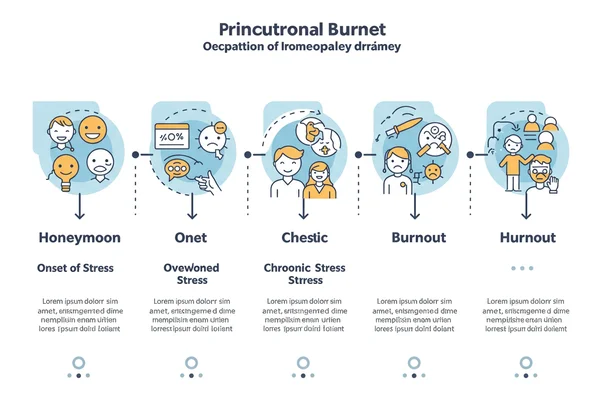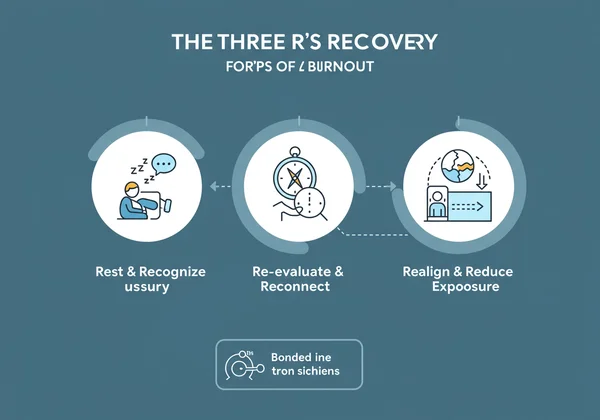What Is Occupational Burnout? Symptoms, Stages, & How to Take a Burnout Test for Recovery
Feeling overwhelmed, exhausted, or detached from your work? You might be experiencing occupational burnout, a widespread phenomenon distinct from regular stress. This is a state of physical, emotional, and mental exhaustion caused by prolonged or excessive stress. What are the five stages of burnout? This guide aims to define what burnout truly is, help you recognize its symptoms and stages, understand its causes, and outline the first steps toward recovery. The first step to understanding your situation is often self-assessment, and you can start your assessment today.

Understanding Occupational Burnout: More Than Just Stress
Occupational burnout is a specific type of work-related stress response. It's not just having a bad week or feeling tired; it's a chronic condition that can deeply impact your health, happiness, and job performance. Officially recognized by the World Health Organization (WHO), it's a legitimate occupational phenomenon that deserves serious attention. Understanding its core components is crucial for recognizing it in yourself and others.
Defining Burnout: Exhaustion, Cynicism, and Reduced Efficacy
Psychologists Herbert Freudenberger and Christina Maslach pioneered the study of burnout, identifying three core dimensions that define the experience. These pillars form the basis of many professional assessment tools, including the widely respected Maslach Burnout Inventory (MBI).

- Exhaustion: This goes beyond normal tiredness. It's a profound emotional and physical depletion where you feel drained and unable to cope. Waking up after a full night's sleep still feeling exhausted is a common sign.
- Cynicism or Depersonalization: This involves feeling negative, cynical, or detached from your job and colleagues. You might distance yourself emotionally from your work, feeling irritable or losing enjoyment in aspects you once found fulfilling.
- Reduced Professional Efficacy: This dimension involves a decline in feelings of competence and achievement at work. You may feel like you're not effective anymore, doubt your abilities, and struggle to see the impact of your contributions.
Burnout vs. Stress: Key Differences and Why It Matters
While stress and burnout are related, they are not the same. Stress is often characterized by over-engagement—a sense of urgency, hyperactivity, and heightened emotions. You might feel like you're drowning in responsibilities but believe you can get back on top if you just push harder.
Burnout, in contrast, is characterized by disengagement. Instead of hyperactivity, you feel helpless and detached. The motivation is gone, replaced by a sense of emptiness. Recognizing this difference is vital because the recovery strategies differ. Managing stress might involve learning to better handle pressure, while recovering from burnout requires a fundamental process of rest and realignment.
Recognizing the Red Flags: Common Burnout Symptoms
Burnout manifests in various ways, affecting your physical health, emotional state, and behavior. Identifying these symptoms is the first step toward addressing the root cause. If you recognize several of these signs, consider taking a free burnout test to gain clearer insight.

Physical & Emotional Exhaustion: The Core Indicators
This is the most prominent symptom. It's not just feeling tired; it's a bone-deep weariness that rest doesn't seem to fix.
- Physical Symptoms: Chronic fatigue, insomnia, frequent headaches, stomach or bowel problems, and increased susceptibility to illness.
- Emotional Symptoms: Feeling drained, a sense of dread about work, and an inability to cope with daily demands.
Detachment & Cynicism: How It Affects Your Work & Life
A growing sense of negativity can poison your perspective on your job, your organization, and your life in general.
- At Work: You might become critical of your job and your colleagues. You may isolate yourself by putting on headphones to block others out or by avoiding social interactions.
- At Home: This negativity can spill over into your personal life, causing you to be irritable with family and friends or to lose interest in hobbies you once enjoyed.
Reduced Performance & Self-Doubt: The Impact on Your Efficacy
Burnout erodes your confidence and productivity. You may find yourself procrastinating, struggling to concentrate, and lacking creativity. This often creates a vicious cycle: poor performance leads to more stress and self-doubt, which in turn deepens the burnout. This is where the question "Is it burnout or am I just lazy?" often arises. Laziness is a choice of inaction; burnout is a state of inability.
The Journey Through Burnout: Understanding the 5 Stages
Burnout doesn't happen overnight. It's a gradual process that can be broken down into five distinct stages. Understanding where you might be on this spectrum can help you intervene before reaching a critical state.

From Honeymoon to Habitual: Navigating Each Phase
- Honeymoon Phase: You begin a new job or role with high energy, commitment, and satisfaction. You readily accept responsibility and are highly productive.
- Onset of Stress: You start to notice more bad days than good. Optimism wanes, and you begin experiencing common stress symptoms like anxiety, fatigue, and irritability.
- Chronic Stress: The stress becomes persistent. Your motivation drops, and you may feel angry or aggressive. You might miss deadlines, feel pressured, and withdraw from social events.
- Burnout: This is the critical stage where symptoms become undeniable. You feel empty, cynical, and obsess over your work problems. Physical and emotional symptoms often intensify.
- Habitual Burnout: Burnout becomes so embedded in your life that you experience significant mental, physical, or emotional problems, such as chronic sadness or depression.
What Causes Burnout? Common Triggers & Contributing Factors
Burnout is not a sign of personal failure. It is often a result of systemic issues in the work environment, though personal traits can also increase vulnerability.
Workplace Pressures: Workload, Lack of Control, & Unfairness
Research consistently points to key workplace factors:
- Unmanageable Workload: Having too much to do and not enough time to do it.
- Lack of Control: Feeling you have little say in decisions that affect your job.
- Insufficient Rewards: Lack of recognition, appreciation, or compensation for your hard work.
- Breakdown of Community: Feeling isolated, dealing with workplace conflict, or having an unsupportive manager.
- Unfair Treatment: Experiencing favoritism, inequity, or disrespect.
Personal Vulnerabilities: Perfectionism, High Achievers, & People-Pleasing
Certain personality traits and lifestyle factors can make you more susceptible to burnout:
- Perfectionistic tendencies: The pressure to be perfect can be exhausting.
- Pessimistic view of self and the world: A negative outlook can fuel feelings of helplessness.
- The need to be in control: A reluctance to delegate can lead to an overwhelming workload.
- High-achieving, Type A personality: A constant drive can make it difficult to rest.
Paving the Path to Recovery: First Steps & Seeking Support
Recovering from burnout is a journey, not a quick fix. It requires conscious effort to rest, re-evaluate your relationship with work, and seek the right support. A great starting point is to objectively assess where you stand with an online burnout assessment.
The Three R's of Recovery: Rest, Re-evaluate, Realign
A helpful framework for recovery is the "Three R's":

- Rest & Recognize: Acknowledge the problem and give yourself permission to step back. This means taking real breaks—daily, weekly, and annually. It also involves practices like mindfulness and prioritizing sleep.
- Re-evaluate & Reconnect: Take time to reflect on what truly matters to you. What are your values, goals, and passions, both in and out of work? Reconnect with supportive relationships and hobbies that bring you joy.
- Realign & Reduce Exposure: Identify the specific stressors causing burnout and take action. This could mean setting boundaries (e.g., not checking emails after hours), talking to your manager about your workload, or, in some cases, considering a new role or career path.
Taking Action: When to Seek Professional Help & Self-Assessment
While self-help strategies are powerful, sometimes professional support is necessary. If your symptoms are severe or you suspect you may be dealing with depression, it's essential to consult a doctor or mental health professional.
For many, the journey begins with self-awareness. A confidential and science-backed job burnout test can provide a structured overview of your risk level across the core dimensions of burnout. A confidential test can help clarify vague feelings of exhaustion and frustration, providing insights that lead to actionable steps.
Moving Forward: Understanding & Taking Action
Occupational burnout is a serious condition that impacts millions of professionals worldwide. By understanding its definition, recognizing its symptoms, identifying its stages, and knowing its causes, you are empowered to take control of your well-being. It’s not about "toughing it out"—it's about recognizing the signs and taking deliberate steps toward recovery and prevention.
If this guide resonates with you, don't wait for things to get worse. Your journey to feeling better starts with a single, informed step. Take our free Burnout Test to get instant, confidential results and discover personalized insights to help you navigate your professional life with renewed energy and purpose.
Frequently Asked Questions About Occupational Burnout
What are the five stages of burnout?
The five commonly cited stages are: 1) The Honeymoon Phase (high satisfaction), 2) Onset of Stress (initial signs of fatigue), 3) Chronic Stress (stress becomes constant), 4) Burnout (critical exhaustion and cynicism), and 5) Habitual Burnout (burnout becomes an ingrained part of your life).
What does burnout fatigue feel like?
Burnout fatigue is a profound exhaustion that isn't relieved by sleep. It feels like a complete depletion of your physical and emotional energy, making it difficult to concentrate, feel motivated, or handle daily tasks. It's often described as "bone-tired" or feeling emotionally numb.
Is it burnout or am I just lazy?
Laziness is typically a reluctance to exert oneself, whereas burnout is an inability to do so due to complete exhaustion. If you were once motivated and productive but now find yourself unable to function and deeply disengaged, it is far more likely to be burnout than laziness.
How do you test for burnout?
You can test for burnout through validated self-assessment questionnaires. These tests, often based on the Maslach Burnout Inventory (MBI), measure key dimensions like emotional exhaustion, cynicism, and professional efficacy. A good place to start is with a confidential and science-backed test to understand your personal risk level.
How can I begin to fix burnout?
The first step is to recognize and acknowledge the problem. Start with the "Three R's": Rest (prioritize sleep and take real breaks), Re-evaluate (reflect on your priorities and stressors), and Realign (set boundaries and reduce exposure to what's draining you). Seeking support from a manager, friend, or professional is also a crucial step.